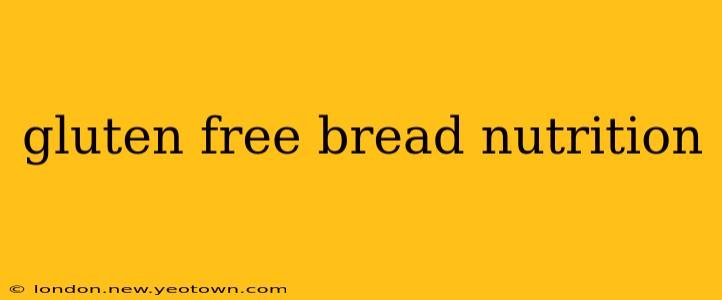The aroma of freshly baked bread, a comforting staple for centuries, can be a bittersweet experience for those following a gluten-free diet. While the joy of enjoying bread remains, understanding the nutritional nuances of gluten-free bread is crucial. This isn't simply a case of swapping ingredients; it's about navigating a landscape of different formulations, each with its own nutritional profile. Let's embark on a journey to uncover the truth about gluten-free bread nutrition.
What are the Nutritional Differences Between Gluten-Free and Regular Bread?
This is a common question, and the answer isn't a simple one. Regular bread, made with wheat flour, provides a good source of carbohydrates, some protein, and fiber. Gluten-free bread, however, varies dramatically depending on the blend of flours used. Often, gluten-free breads rely on rice flour, potato flour, tapioca starch, or blends thereof. These alternative flours often lack the fiber and protein content found in wheat flour. This means that gluten-free bread may be lower in fiber, potentially leading to less satiety and potentially impacting blood sugar control. The protein content can also be significantly lower.
Is Gluten-Free Bread Less Nutritious Than Regular Bread?
This is a key concern for many. The short answer is: not necessarily. While gluten-free breads may lack certain nutrients found in wheat bread, they can be fortified with vitamins and minerals. Manufacturers often add iron, folic acid, and B vitamins to compensate for the nutritional gaps. However, reading labels carefully is essential. The nutritional content can vary widely depending on the brand and ingredients.
How Many Calories are in Gluten-Free Bread?
Calorie content is another variable. A slice of gluten-free bread can range anywhere from 60 to 100 calories, sometimes even higher, depending on the ingredients. Added fats, sugars, and other ingredients will significantly influence the overall calorie count. Again, careful label reading is paramount.
Does Gluten-Free Bread Have Less Fiber?
Generally, yes. Gluten-free bread often has a lower fiber content than traditional wheat bread. Wheat flour naturally contains more fiber. However, some gluten-free breads are specifically formulated to increase fiber content through the addition of ingredients like flaxseed meal, psyllium husk, or other high-fiber flours. Look for brands that highlight high-fiber content if this is a priority for you.
What Are the Best Gluten-Free Breads for Nutrition?
There's no single "best" gluten-free bread, as individual nutritional needs vary. However, when selecting a gluten-free loaf, look for:
- High fiber content: This aids digestion and promotes satiety.
- Whole grains: Look for blends that include whole grains like brown rice or quinoa flour.
- Lower sugar content: Avoid breads with excessive added sugars.
- Minimal processed ingredients: Opt for breads with simpler ingredient lists.
- Added vitamins and minerals: Many gluten-free breads are fortified with essential nutrients.
The best approach is to read labels carefully and compare nutritional information across different brands to find a bread that aligns with your dietary needs and preferences.
Conclusion: Navigating the Gluten-Free Bread Aisle
Choosing gluten-free bread requires a thoughtful approach. It’s not about simply avoiding gluten; it's about finding a nutritious and satisfying alternative that meets your individual needs. By understanding the potential nutritional differences and paying close attention to ingredient lists, you can make informed choices and continue to enjoy the comfort and pleasure of bread as part of a healthy, gluten-free lifestyle. Remember, a diverse diet, including a variety of fruits, vegetables, and other whole foods, is essential for overall health, regardless of dietary restrictions.

